Introduction
Protecting your business’s intellectual property is crucial for fostering growth, maintaining competitive advantage, and safeguarding your creations and innovations. Understanding the differences between copyright, trademark, and patent protections empowers business owners to make informed decisions about securing their assets. Each form of intellectual property coverage serves unique purposes—from protecting creative expressions to defending innovative inventions and preserving your brand identity. This comprehensive overview explores these distinctions in detail, guiding you through their definitions and core purposes, legal protections and durations, the scope of what each covers, the application processes, commercial implications, and common enforcement challenges. Armed with this knowledge, you’ll be better prepared to navigate the complexities of intellectual property and strategically protect what drives your business forward.
Tables of Contents
Chapter 1: Understanding Copyright vs Trademark vs Patent: Definitions and Core Purposes
- How Copyright Protects Original Creative Expression in Intellectual Property Law
- How Copyright, Trademark, and Patent Protect Brand Identity and Market Position
- How Copyright, Trademark, and Patent Protect Different Aspects of Technological Innovation
Chapter 2: Legal Protections and Duration Differences in Copyright vs Trademark vs Patent
- Unpacking What Each Intellectual Property Shield Actually Covers
- Navigating Duration and Renewal: How Copyright, Trademarks, and Patents Differ in Maintaining Legal Rights
- How Duration and Legal Protections Shape Innovation, Economy, and Culture
Chapter 3: Scope of Protection: What Copyright vs Trademark vs Patent Covers
- Exploring Copyright’s Reach: Protecting Original Literary and Artistic Creations
- How Trademarks Shape Brand Identity and Ensure Consumer Trust
- Defining Patent Protection: How Claims Shape the Reach of Technological Inventions
Chapter 4: Navigating the Legal Pathways: Process and Requirements for Obtaining Copyright, Trademark, and Patent Protection
- Distinct Legal Foundations and Registration Procedures Shaping Copyright, Trademark, and Patent Protections
- Duration, Enforcement, and Maintenance: Key Legal Milestones in Securing Copyright, Trademark, and Patent Rights
- Distinct Purposes and Protection Scopes: Navigating Requirements for Copyright, Trademark, and Patent
Chapter 5: Economic and Commercial Impacts of Copyright, Trademark, and Patent Protections
- Harnessing Intellectual Property: Economic Benefits of Protecting Creativity, Brands, and Innovation
- Navigating Cost and Duration Realities: How Each IP Type Shapes Commercial Strategy
- Harnessing Intellectual Property for Business Growth: Licensing, Brand Loyalty, and Innovation Incentives
Chapter 6: Navigating Complexities: Enforcement Challenges of Copyright, Trademark, and Patent Laws
- The Intersection of Technology and Law: Overcoming Enforcement Barriers in Copyright, Trademark, and Patent Protection
- How Enforcement Challenges Shape Global Innovation, Trade, and Cultural Influence
- Balancing Societal Interests and Strategic Responses in Intellectual Property Enforcement
Chapter 1: Understanding Copyright vs Trademark vs Patent: Definitions and Core Purposes
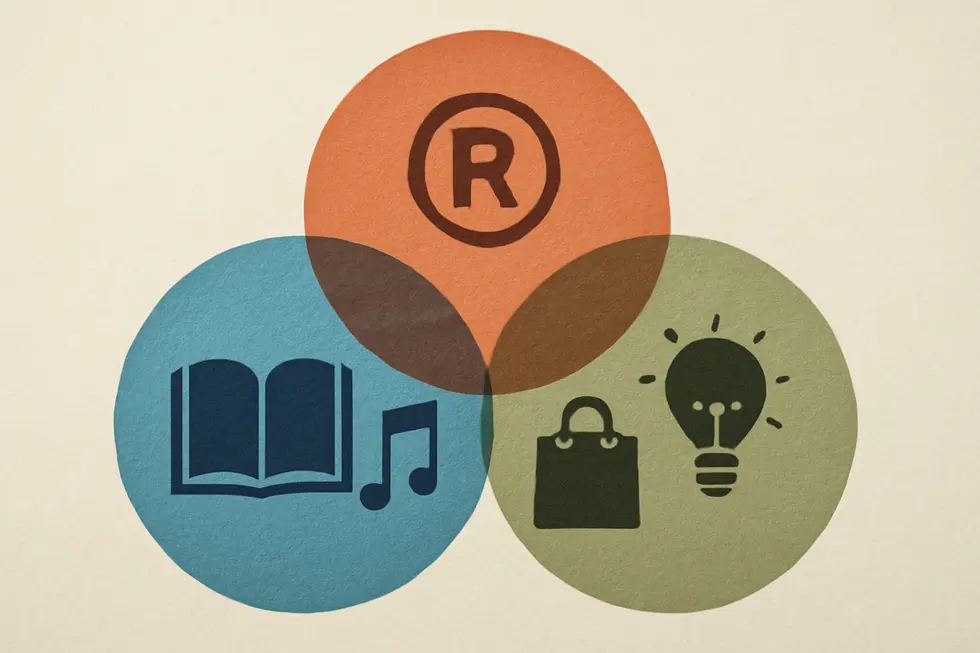
1. How Copyright Protects Original Creative Expression in Intellectual Property Law
Copyright serves as a vital legal shield for original creative expressions fixed in tangible forms. Unlike patents or trademarks, copyright does not extend to ideas themselves but protects how these ideas are uniquely expressed—whether in literature, music, art, software, or film. This protection arises automatically as soon as a work is created and fixed, granting creators exclusive rights to reproduce, distribute, and publicly perform or display their works. These rights typically endure for the life of the author plus 70 years, ensuring long-term safeguarding of the creator’s legacy. While registration is optional, it offers enhanced legal benefits, such as eligibility for statutory damages and easier enforcement against infringement. Copyright is distinct from trademark, which safeguards brand identifiers like names and logos, and from patents, which protect new inventions and technological innovations. Understanding copyright’s core function is essential for authors and businesses to defend their creative assets effectively without confusing these protections with those designed for brands or inventions. For more insights on how copyright functions in a business setting and its relation to trademarks, see the detailed explanation on copyright and trademark law for business owners. Additionally, a comprehensive overview of intellectual property types is available at ebizfiling.com[1].
2. How Copyright, Trademark, and Patent Protect Brand Identity and Market Position
Copyright, trademark, and patent serve distinct yet complementary roles in securing a brand’s market position and identity. Copyright safeguards the original creative expressions embedded in works like books, music, and software code. It protects how ideas are presented, not the ideas themselves, granting creators exclusive rights to reproduce, distribute, or adapt their creations. This protection arises automatically once a work is fixed in a tangible form but registering can strengthen legal claims.
In contrast, trademark focuses on brand identifiers—names, logos, slogans—that distinguish a company’s goods or services. By protecting these marks, trademarks prevent consumer confusion and preserve the goodwill tied to a brand identity. Their protection can last indefinitely, as long as the marks are used consistently and properly renewed, reinforcing market recognition and consumer trust.
Patents differ by protecting technical and functional innovations such as inventions or processes. They grant inventors exclusive rights for a limited time, usually 20 years, encouraging innovation while balancing public access. Patents require rigorous examination to ensure novelty and non-obviousness.
Together, these protections form a powerful framework: copyright defends creative content, trademarks secure brand identity in commerce, and patents shield technological advances. This trio enables businesses and creators alike to build, distinguish, and protect their market presence effectively. For more insights on trademark protection, see trademark protection for business name and logo.
External resource: https://www.uspto.gov/patents/basics
3. How Copyright, Trademark, and Patent Protect Different Aspects of Technological Innovation
Intellectual property (IP) protection plays distinct roles in fostering technological progress. Patents are the cornerstone for safeguarding inventions. They grant inventors exclusive rights to make, use, or sell new devices, processes, or chemical compositions for about 20 years. This exclusivity incentivizes innovation by allowing creators to control commercial exploitation and recover development costs. Obtaining a patent involves a thorough review of novelty and utility, ensuring only genuine advances receive protection.
Trademarks, while not protecting inventions themselves, secure the brand identity connected to products and services that emerge from these inventions. By registering trademarks—like names, logos, or slogans—businesses prevent consumer confusion and build reputations, which are critical in competitive markets. Unlike patents, trademarks can last indefinitely if actively maintained.
Copyright complements these protections by shielding the creative expressions related to technology. This includes software code, manuals, or multimedia presentations that embody or promote innovations. However, it does not extend to the underlying functional ideas or inventions. Copyright arises automatically upon creation but registering it provides stronger enforcement.
Together, these three IP types create a comprehensive legal framework: patents defend the invention’s technical core, trademarks secure its market identity, and copyright preserves the creative elements that accompany it. Understanding their interplay is essential for anyone aiming to protect innovations effectively.
For more detailed guidance on trademarks protecting business identity, see this resource on trademark protection for business names and logos.
Chapter 2: Legal Protections and Duration Differences in Copyright vs Trademark vs Patent
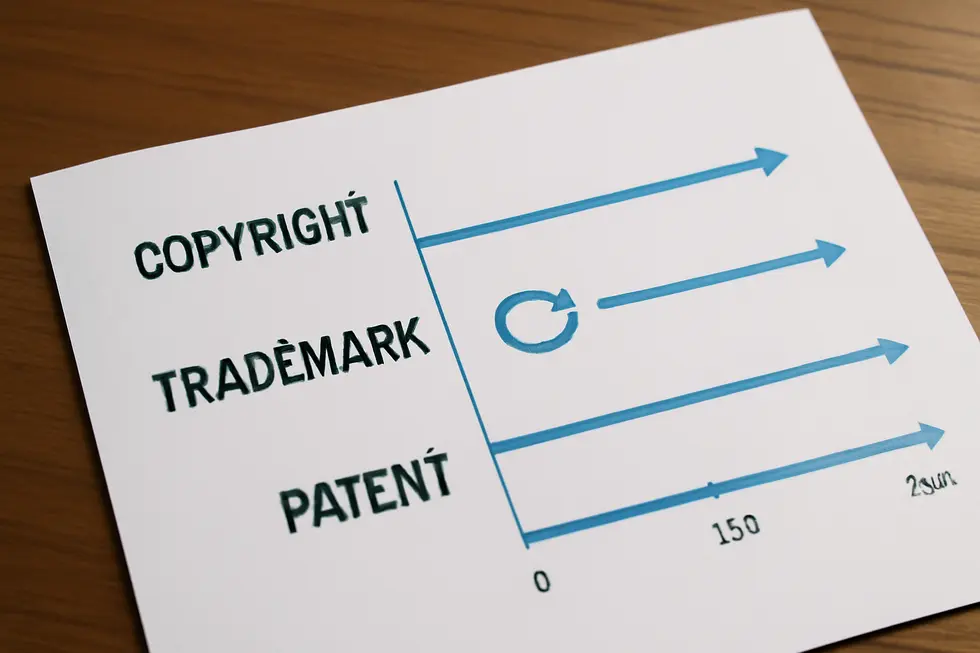
1. Unpacking What Each Intellectual Property Shield Actually Covers
Understanding the Distinct Legal Protections Offered by Copyright, Trademark, and Patent
Each type of intellectual property protection targets different assets with unique legal safeguards. Copyright secures original creative works, including literature, music, art, films, and software. It protects the expression of ideas fixed in a tangible form, not the ideas themselves, offering rights to reproduce and distribute the work automatically upon creation. This protection generally endures for the life of the author plus 70 years, sometimes extended for corporate works.
In contrast, trademarks protect brand identifiers like logos, names, and slogans that distinguish goods or services in commerce. Trademarks aim to prevent consumer confusion by safeguarding a brand’s identity and goodwill. Unlike copyright, trademark rights depend on actual use in commerce and can last indefinitely with proper renewal and continuous use, often strengthened through registration.
Patents focus on new inventions or functional innovations, such as processes, machines, or chemical compositions. They grant inventors exclusive rights to make, use, or sell their inventions for a limited period, typically 20 years from the filing date. Patents require a formal application and examination to prove the invention’s novelty and utility.
Recognizing these differences clarifies which legal protection applies to a creative work, brand element, or invention. For more detailed insights on trademark safeguards for business names and logos, explore this comprehensive discussion on trademark protection.
For further detailed guidance, consult the authoritative overview outlined at ebizfiling.com.
2. Navigating Duration and Renewal: How Copyright, Trademarks, and Patents Differ in Maintaining Legal Rights
Duration and Renewal Nuances in Intellectual Property Protections
Copyright, trademark, and patent protections are governed by distinct duration and maintenance rules that reflect their unique purposes. Copyright offers long-lasting protection, extending through the author’s lifetime plus 70 years, or up to 95 years for corporate works. Once an original work is fixed in a tangible form, copyright protection arises automatically with no renewal or maintenance fees required, though registering the work can enhance legal enforceability.
Trademarks, however, thrive on continuous commercial use to maintain their value. They can last indefinitely, but trademark owners must actively use the mark in commerce and meet periodic renewal deadlines—typically every 10 years in jurisdictions like the U.S.—to retain full protection. Failure to use or renew a trademark risks losing exclusive rights, emphasizing upkeep as an ongoing obligation.
Patents contrast sharply by granting temporary exclusivity—commonly 20 years from the filing date for utility patents. This limited term encourages innovation while balancing public access. Maintenance fees must be paid periodically (such as at 3.5, 7.5, and 11.5 years in the U.S.) or the patent will lapse prematurely. Unlike copyright and trademark, patents require rigorous application processes and consistent fee payments to remain active.
These varying durations and maintenance protocols highlight how each intellectual property type aligns legal rights with its functional role—from enduring creative expression and perpetual brand identity to time-limited technological advancements.
For deeper insight into trademarks, see trademark protection for business names and logos.
External Resource: https://trademark2go.com/categories-intellectual-property-rights/
3. How Duration and Legal Protections Shape Innovation, Economy, and Culture
The varying legal protections and durations of copyrights, trademarks, and patents distinctly influence innovation, economic growth, and societal evolution. Trademarks offer indefinite protection as long as maintained, empowering brands to build lasting consumer trust and market presence. This ongoing brand identity support is vital in competitive industries, enhancing consumer confidence and encouraging businesses to invest in quality and reputation.
Patents grant inventors exclusive rights typically for about 20 years, a limited window that incentivizes disclosure and development of new technologies. This balance encourages inventors to innovate while ensuring inventions eventually enter the public domain to spur further progress. Through such exclusivity, patents foster significant R&D investment, driving economic leadership and technological evolution.
Copyrights protect creators’ original works for life plus 70 years (or longer for corporate authorship), supporting cultural and creative sectors economically by prolonging rights and royalties. However, long copyright terms may restrict public access and derivative creativity, highlighting an intricate trade-off between creator benefits and societal enrichment.
Together, these protections form a framework that encourages technological advancement, sustains economic value, and preserves cultural expression. Their distinct durations and legal scopes weave a complex interplay affecting how ideas, brands, and inventions flourish over time. For further insight, explore trademark protection for brand identifiers in business here. Additional detailed analysis can be found at Dilworth IP.
Chapter 3: Scope of Protection: What Copyright vs Trademark vs Patent Covers
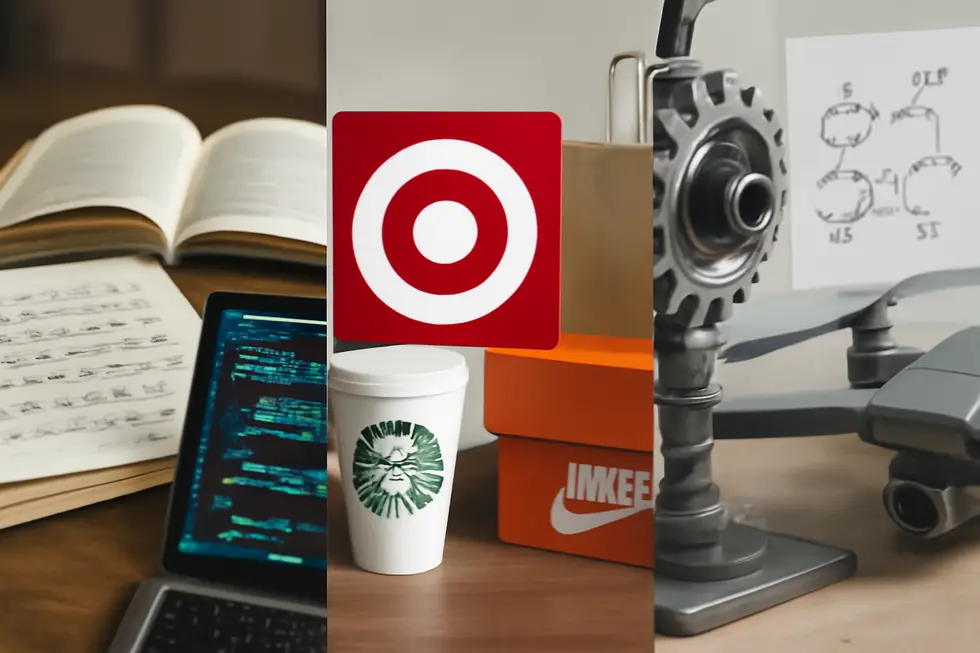
1. Exploring Copyright’s Reach: Protecting Original Literary and Artistic Creations
Copyright protection safeguards original works of authorship fixed in a tangible medium, spanning a vast array of creative domains. This includes literary works like novels, poems, essays, and plays, as well as artistic expressions such as paintings, sculptures, and photographs. Additionally, copyright extends to musical compositions, sound recordings, dramatic scripts, audiovisual works including films, software code, and even architectural designs. To qualify, a work must demonstrate originality—meaning it is independently created with minimal creativity—and be fixed in a form perceivable directly or with aid, such as written text or recorded media.
Importantly, copyright protects the expression of ideas, not the ideas themselves. This distinction ensures creators own the unique way they present concepts, but cannot monopolize facts or general knowledge. Rights granted include control over reproduction, distribution, public performance or display, and adaptations, alongside moral rights that safeguard an author’s attribution and the integrity of visual arts.
Unlike patents or trademarks, copyright protection arises automatically upon creation without registration, though registering can strengthen legal enforcement. Its broad scope enables creators in diverse fields to secure exclusive rights over their original artistic and literary expressions, ensuring their creative investment is legally recognized and protected.
For deeper insights into what specifically qualifies as protected works, consult authoritative guides such as copyright information for books.
2. How Trademarks Shape Brand Identity and Ensure Consumer Trust
Trademarks serve as essential protectors of a brand’s unique identity, covering distinctive elements that set products or services apart in the marketplace. These include names (word marks), logos (design marks), slogans, colors, sounds, and even packaging designs, all of which help consumers instantly recognize the source behind a product. A trademark grants the owner exclusive legal rights to these identifiers, shielding against unauthorized use or imitation that could dilute or confuse the brand’s reputation.
The legal scope of trademark protection depends significantly on the nature of the registration. Federal trademarks in the U.S. offer nationwide coverage and the right to use the ® symbol, bolstering a brand’s enforceability across states. State trademarks provide localized protection but can be limited if a federal registration exists. Beyond singular marks, brands often develop portfolios incorporating various forms—names, logos, slogans, colors, and sounds—to comprehensively defend their market presence and prevent dilution or misuse globally.
Trade dress, which includes the overall visual appearance and packaging that signify the brand, can also be protected if it has acquired distinctiveness or secondary meaning with consumers. By safeguarding these elements, trademarks not only build consumer trust but also secure the brand’s competitive advantage.
For businesses exploring trademark rights for names and logos, insightful guidance is available on trademark name and logo protection.
External reference: https://en.wikipedia.org/wiki/Trademark
3. Defining Patent Protection: How Claims Shape the Reach of Technological Inventions
Patent protection grants exclusive rights to inventors over their technological innovations, defined precisely by the patent’s claims. These claims outline the essential features of an invention, whether it’s a device’s physical components or a sequence of procedural steps. Such specificity forms the legal boundary that determines what others cannot make, use, or sell without permission, typically lasting around 20 years from the filing date. Unlike trademarks or copyrights, patents create a “negative right”—they prevent others from unauthorized exploitation rather than granting a positive right to use.
The breadth of patent protection depends on how comprehensively its claims are drafted. Inventors often include multiple claim variations to cover different configurations, materials, or methods, deterring competitors from easily circumventing the patent. Importantly, patents do not cover abstract ideas or natural phenomena themselves but protect novel and useful applications derived from them. For example, genetically engineered microorganisms may be patented, but naturally occurring DNA sequences cannot. Understanding this scope helps clarify how patents secure innovation while balancing public access.
This nuanced protection is crucial for inventors seeking to safeguard functional advancements in technology, distinguishing patent coverage clearly from copyrights or trademarks. For deeper analysis on evaluating patent infringement and claim scope, see expert commentary by Serjeants here.
Chapter 4: Navigating the Legal Pathways: Process and Requirements for Obtaining Copyright, Trademark, and Patent Protection
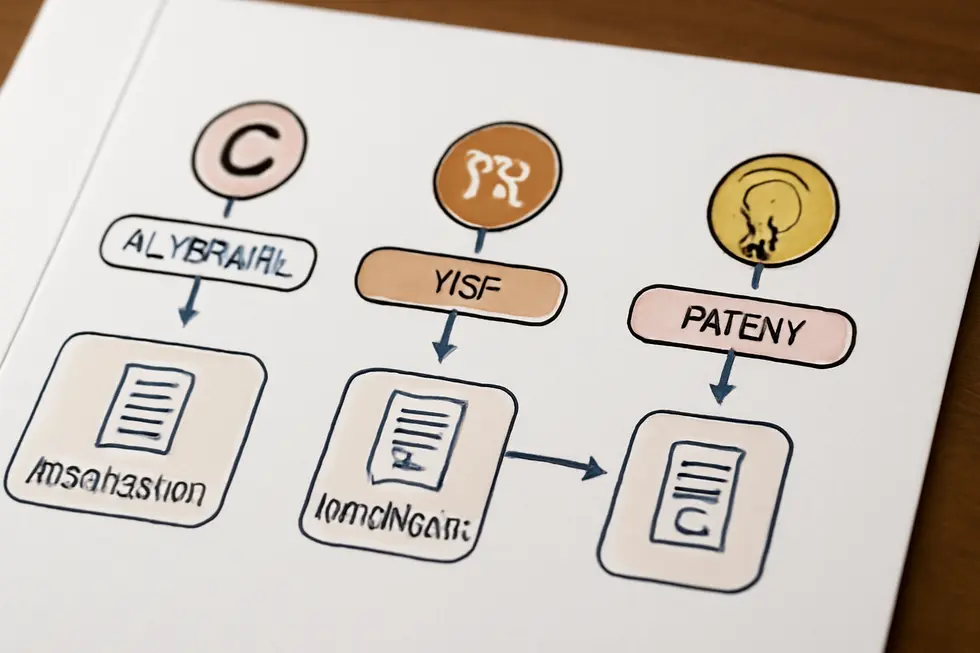
1. Distinct Legal Foundations and Registration Procedures Shaping Copyright, Trademark, and Patent Protections
Copyright, trademark, and patent protections operate under fundamentally different legal frameworks that reflect their unique purposes. Copyright protection arises automatically once an original work is fixed in a tangible form, yet registration with the U.S. Copyright Office enhances enforcement by providing public record and access to statutory remedies. The registration process is relatively straightforward—complete an application, submit copies of the work, and pay a modest fee, with processing typically taking several months. Trademark protection, by contrast, centers on brand identifiers that distinguish goods or services in commerce. To secure exclusive rights, one must register the mark through the USPTO by proving actual or intended commercial use. Unlike copyright, trademark rights can be maintained indefinitely through continued use and timely renewals, demanding vigilant monitoring to avoid dilution or infringement. Patent protection offers a more rigorous and technical registration journey: inventors must submit detailed, precise disclosures of their inventions and claims for examination. This process can be lengthy and requires meeting strict novelty and non-obviousness standards. Successful patents grant exclusive rights typically for 20 years, empowering inventors to exclude others from exploiting their innovations. Together, these distinct processes reflect how legal systems tailor intellectual property protection to different creative and commercial needs. For businesses seeking to safeguard their brand identity, understanding trademark specifics is crucial, as detailed in trademark protection insights. Additional authoritative guidance is available via the U.S. Copyright Office and USPTO websites, which detail registration steps, fees, and enforcement mechanisms essential to securing and maintaining rights.
2. Duration, Enforcement, and Maintenance: Key Legal Milestones in Securing Copyright, Trademark, and Patent Rights
The path to securing intellectual property protection varies for copyright, trademarks, and patents, especially regarding duration, enforcement, and maintenance. Copyright protection is automatic upon the creation and fixation of an original work, lasting for the author’s life plus 70 years or longer for corporate works, without the need for formal maintenance. Registration is optional but strengthens enforcement by enabling claims to statutory damages and attorney fees.
Trademarks, by contrast, protect identifiers like names and logos indefinitely, provided the mark remains in active use and the owner meets ongoing renewal obligations. In the U.S., trademark holders must file a Declaration of Continued Use between the fifth and sixth year after registration and renew registrations every ten years. Failure to meet these maintenance requirements may lead to cancellation. Enforcement of trademark rights focuses on preventing consumer confusion, requiring vigilant monitoring and swift legal action against infringers.
Patent protection is strictly limited to about 20 years from the filing date and demands a formal application vetted through a rigorous examination process that assesses novelty, utility, and non-obviousness. Maintaining patent rights involves periodic maintenance fee payments. Without timely payments, the patent expires before term end.
All three types require active enforcement efforts to uphold rights and prevent infringement. However, their legal mechanisms and temporal boundaries reflect their different goals: expression, brand identity, and innovation respectively. For additional insights on trademark registration processes and maintaining brand protection, see trademark protection for business names and logos.
(Source: https://trademark2go.com/trademark-protection-business-name-logo/)
3. Distinct Purposes and Protection Scopes: Navigating Requirements for Copyright, Trademark, and Patent
The processes and requirements for obtaining copyright, trademark, and patent protections differ sharply, reflecting their unique purposes and scopes. Copyright safeguards original creative expressions fixed in tangible form, such as literature, music, and software, automatically granting rights upon creation. Registration is optional but enhances enforcement. In contrast, trademarks protect brand identifiers—names, logos, and slogans—that distinguish goods or services in commerce. Trademark protection requires formal registration and continuous use to maintain rights, emphasizing brand identity in the marketplace. Patents focus on securing exclusive rights for novel inventions or technological processes that are useful and non-obvious. Their protection only begins after a rigorous examination process by the patent office, demanding detailed disclosure and justification of novelty.
The scope of copyright excludes ideas and functional aspects, strictly covering the fixed expression itself. Trademarks protect symbols and trade dress linked to commercial origin but do not extend to product functionality. Patents uniquely cover the functional mechanisms, processes, and compositions behind inventions. Duration also varies: copyrights typically last the author’s life plus 70 years, trademarks can endure indefinitely with proper maintenance, and patents grant approximately 20 years of exclusive rights before entering the public domain.
This framework clarifies that while copyright secures creative content effortlessly, trademarks require active brand management, and patents incentivize innovation through formal vetting and limited exclusivity. For businesses, understanding these distinctions ensures appropriate intellectual property strategies across creative works, brand identity, and inventions. More insights on trademark protections are available at trademark protection for business names and logos.
For further detailed guidance, consult reputable external resources such as upcounsel.com’s explanation on the differences among patents, trademarks, and copyrights.
Chapter 5: Economic and Commercial Impacts of Copyright, Trademark, and Patent Protections

1. Harnessing Intellectual Property: Economic Benefits of Protecting Creativity, Brands, and Innovation
Copyright, trademark, and patent protections play distinct yet complementary economic roles by safeguarding unique types of intellectual property. Copyrights secure original creative works such as literature, music, films, and software, granting creators exclusive rights to reproduce and monetize their creations. This protection encourages investment in creative industries, fosters job creation, and combats piracy, thus fueling economic activity across publishing and entertainment sectors. By contrast, trademarks protect brand identifiers—names, logos, and slogans—that differentiate goods and services in the marketplace. They build economic value through enhanced consumer trust, loyalty, and reputation, which influence purchasing decisions and strengthen a business’s competitive edge. Trademarks also deter counterfeit goods, preserving the integrity of brands and consumer safety over indefinite periods with continued use and renewal. Patents focus on protecting technological innovations and new inventions for a limited term, typically 20 years, incentivizing research and development by allowing inventors to profit from licensing or exclusive sales. This protection drives advancement in critical industries like pharmaceuticals and technology, establishing market exclusivity and shaping product life cycles. Together, these protections form an economic framework that sustains creativity, brand equity, and innovation, encouraging investment and growth in diverse commercial ecosystems. Businesses benefit from strategically leveraging these intellectual property rights to secure assets and maximize revenue streams. For further details on how these rights distinctly protect creative content and brand assets, see categories of intellectual property rights.
Source: https://www.dilworthip.com/resources/news/trademark-vs-copyright-vs-patent/
2. Navigating Cost and Duration Realities: How Each IP Type Shapes Commercial Strategy
Cost and Duration Differences Define Economic Viability
Understanding the financial and temporal commitments tied to copyright, trademark, and patent protections is vital for businesses seeking to optimize intellectual property assets. Patents, often the most costly, demand detailed technical submissions and legal support, driving expenses into thousands of dollars. The rigorous application process extends over years, reflecting a significant upfront investment rewarded by exclusive rights for about 20 years. This limited term fuels innovation while ensuring public access post-expiration.
Trademarks, in contrast, offer more cost-effective and flexible brand protection. Application fees vary by jurisdiction, with options like the Madrid Protocol facilitating strategic international filings. Trademark rights can persist indefinitely, so long as the mark remains in active use and renewals are maintained, supporting sustained brand equity without prohibitive costs.
Copyrights provide automatic, long-lasting protection—often for the author’s life plus 70 years—with minimal initial registration fees. While enforcement and licensing carry associated costs, this IP type enables creators to generate consistent revenue streams over time.
Selecting between these protections entails weighing immediate expenses against long-term commercial value, carefully aligning intellectual property strategy with business priorities.
For deeper insights into managing brand identity, exploring trademark protection for business names and logos can be invaluable: trademark protection business name logo.
3. Harnessing Intellectual Property for Business Growth: Licensing, Brand Loyalty, and Innovation Incentives
Intellectual property protections—copyright, trademark, and patent—play distinct yet complementary roles in shaping economic and commercial strategies. Licensing emerges as a critical business tool, where patents often generate revenue through royalty agreements and exclusive or non-exclusive licenses, supporting ongoing innovation and diversifying income streams. Trademarks extend brand reach by licensing brand identifiers, maintaining consistency and trust across markets, while copyrights facilitate licensing in creative fields like publishing and software, enabling controlled distribution and monetization of original works.
Brand loyalty is most directly tied to trademarks, which safeguard names and logos that foster consumer trust and repeat business. By preventing counterfeit goods, trademarks protect brand reputation and consumer safety. Meanwhile, copyrights underpin brand identity through protected creative content such as advertising and design elements, and patents contribute indirectly by enabling unique features that differentiate products.
Innovation incentives vary by protection type but together fuel economic progress. Patents reward inventors with temporary monopolies, encouraging R&D investments and public disclosure that propels future advances. Copyrights encourage creative expressions by securing long-term exclusive rights, while trademarks motivate businesses to innovate in branding and marketing to stand out.
Businesses often combine these protections to maximize competitive advantage, aligning licensing, brand loyalty, and innovation incentives into robust commercial strategies that fuel sustainable growth. For a detailed understanding of trademark roles in business, see trademark protection for business name and logo.
Chapter 6: Navigating Complexities: Enforcement Challenges of Copyright, Trademark, and Patent Laws
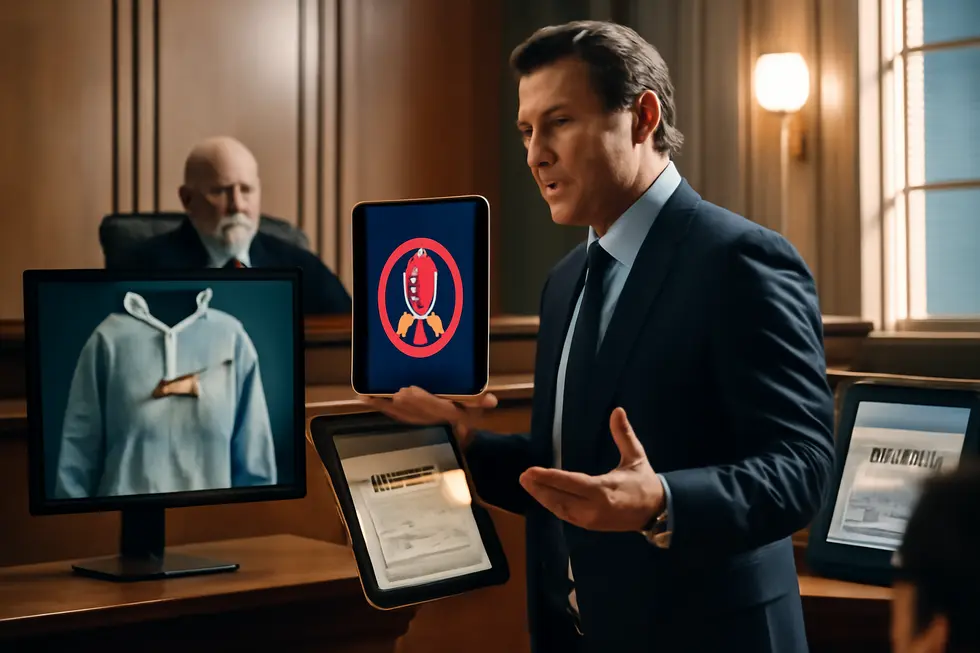
1. The Intersection of Technology and Law: Overcoming Enforcement Barriers in Copyright, Trademark, and Patent Protection
Enforcing intellectual property rights under copyright, trademark, and patent law presents unique challenges heightened by technological advances, especially with AI’s growing role. Copyright enforcement grapples with the legal ambiguity surrounding AI-generated content and the widespread copying of copyrighted works for AI training, raising issues about unauthorized reproduction and fair use. Current statutes like the DMCA were not designed with such technologies in mind, complicating ownership and infringement claims. Meanwhile, AI tools enhance detection but introduce concerns about accuracy and fairness.
Trademark enforcement requires a delicate balance of technology and human judgment. AI-assisted search tools can quickly scan large trademark databases but often miss subtle cultural or phonetic similarities and unregistered, common law marks, leading to potential infringement disputes. Legal interpretation of likelihood of confusion remains complex and cannot be fully automated, necessitating combined AI and expert analysis.
Patent enforcement faces hurdles from dense patent landscapes, often described as “patent thickets,” making infringement avoidance difficult for innovators. Patent trolls exploit vague patents, escalating litigation and financial risks. The legal system continues to struggle with encouraging innovation while preventing monopolistic barriers, particularly in essential sectors like healthcare.
Collectively, these enforcement issues highlight a dynamic interplay between emerging technologies and existing IP law frameworks, demanding adaptive legal approaches and advanced, context-aware tools to effectively protect creators, brands, and inventors. For deeper context on trademark nuances, consider reviewing this resource on common law trademark rights.
(Source: [2])
2. How Enforcement Challenges Shape Global Innovation, Trade, and Cultural Influence
Enforcement of copyright, trademark, and patent rights carries distinct economic and geopolitical repercussions rooted in the nature of each intellectual property type. Patents, by protecting technological breakthroughs, serve as powerful tools for nations and corporations to assert global innovation leadership and secure strategic advantage. Control over critical technologies like AI and clean energy not only boosts economic strength but also grants geopolitical leverage by shaping international standards and influencing global supply chains. This leads governments to prioritize expedited patent processing and tighten export controls to safeguard these innovations. Conversely, copyright enforcement is intricately tied to diverse legal traditions and cultural values, affecting the cross-border use and monetization of creative works. Variations in enforcement rigor and societal attitudes towards fair use influence how copyrighted materials circulate globally, complicating economic returns and cultural exchange. Trademarks focus primarily on protecting brand identity and consumer trust, which are vital to economic competition and market stability. Ineffective trademark enforcement risks brand dilution and unfair competition, undermining consumer confidence and international trade relations. Although trademarks have less direct national security implications than patents, they remain key to maintaining fair global commerce through robust market regulation. Together, enforcement dynamics across these intellectual property rights sculpt the intertwined economic and geopolitical landscapes of innovation, culture, and trade. For more on the intersection of IP law and national strategy, see IP Law and National Security: Where Innovation Policy Meets Defense. For additional insights on brand protection, visit trademark protection for businesses.
3. Balancing Societal Interests and Strategic Responses in Intellectual Property Enforcement
The enforcement and societal challenges of copyright, trademark, and patent protections reflect their unique aims but collectively shape innovation and market trust. Copyright safeguards creators’ original works, fostering cultural growth, yet strict enforcement may restrict public access and impede smaller developers’ adaptation of creative content. This tension demands strategic licensing and legal evolution to keep pace with technologies like AI and cloud platforms. Trademarks underpin consumer confidence by distinguishing brands, but the digital era introduces risks such as counterfeiting and disputes over user-generated content on social media. Businesses must carefully balance protection with respect for expression, often deploying AI-powered monitoring to manage infringement without alienating their audience. Patents incentivize innovation via exclusive rights but risk monopolies limiting access to crucial technologies, notably in healthcare. Policymakers and firms must reconcile exclusivity with competition and affordability, especially as AI blurs traditional notions of inventorship. Effective strategic management across these protections hinges on adaptable laws and technology-enabled enforcement, ensuring IP rights sustain creativity, economic progress, and consumer welfare. For deeper insights on intellectual property categories and their roles, see categories of intellectual property rights. External perspectives on AI’s impact can be explored at gowlingwlg.com.
Final thoughts
Effectively protecting your business’s intellectual property demands a clear understanding of the distinctions between copyright, trademark, and patent. Each form of protection serves a unique role—copyright secures the creative expressions that shape your brand narrative; trademark defends the identity that customers recognize and trust; and patent safeguards the innovative inventions that drive your competitive edge. Knowing the legal scope, duration, and processes tied to each type empowers you to strategically secure your intellectual assets, avoid costly pitfalls, and maximize your economic benefits. Remaining vigilant about enforcement challenges further strengthens your ability to maintain exclusivity and deterrence against infringers. Ultimately, integrating these protections where appropriate is fundamental to fostering sustainable business growth and innovation.
Your IP is the foundation of your success – let’s protect it together before it’s too late. We can’t wait to help you turn your ideas into legally secured assets.
About us
undefined


